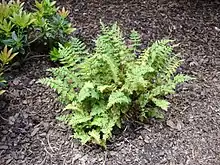| Dickie's bladder-fern | |
|---|---|
 | |
| Scientific classification | |
| Kingdom: | Plantae |
| Clade: | Tracheophytes |
| Division: | Polypodiophyta |
| Class: | Polypodiopsida |
| Order: | Polypodiales |
| Suborder: | Aspleniineae |
| Family: | Cystopteridaceae |
| Genus: | Cystopteris |
| Species: | C. dickieana |
| Binomial name | |
| Cystopteris dickieana Sim[1] | |
Cystopteris dickieana, commonly known as Dickie's bladder-fern, is a fern with a wide distribution in the Northern Hemisphere. There is debate amongst botanists as to whether it is a species in its own right or a variant of C. fragilis.
Distribution
C. dickieana is native to Canada and the United States, a variety of European countries including Russia and also north Africa and the Andes. It is typically found in montane habitats below the tree-line, although it is also grows at lower altitudes in locations with cool summers.[1]
Discovery and Victorian collectors
The first recorded discovery of the plant was made by William Knight, Professor of Natural Philosophy at Marischal College, Aberdeen in Scotland. Knight came across a small population growing on base-rich rocks in a sea cave (known locally as a "yawn") on the coast of Kincardineshire. The first publication to record it was the 1838 Flora Aberdonenis which included a note of its occurrence written by a pupil of Knight's, George Dickie. Dickie also sent a live specimen to Robert Sim, a nurseryman from Kent, who believed it to be a new species and published his views in the 1848 edition of the Gardener's and Farmer's Journal, naming it C. dickieana.[1]
Rarer British ferns came under severe threat from Victorian fern collectors in the mid 19th century in Scotland, a period of collecting that became known as Pteridomania (or "fern-fever"). In 1860 Dickie reported that the original colony had been extirpated from the yawn where its original discovery had occurred. The evidence for this is conflicting, but today there is a population of more than 100 plants there, where it grows in a roof fissure in the company of Athyrium filix-femina and Dryopteris dilatata.[1][2][3]
Taxonomic controversy
Taxonomic classification within the genus Cystopteris is complex. Within a year of Sim's publication Thomas Moore stated his view was that, on balance, Dickie's Bladder-fern was a variety of C. fragilis. Various opinions have been published over the intervening years, with a consensus that C. dickeana was a separate species emerging in the 1930s, although recent research suggests that Moore's caution may have been appropriate.[1][4] C. dickeana has broader, less divided and more closely spaced pinnae than C. fragilis and the spores of the former are typically wrinkled and ridged rather than the spiny form of the latter's. However, there are significant variations within the populations of both forms and these characteristics are by no means fixed. On the other hand, there is also evidence that crosses of the two types produce sterile hybrids.[1] C. Xmontserratii (Prada & Salvo) Fraser-Jenkins is a proposed hybrid between C. dickeana and C. fragilis.
The treatment of Cystopteris in the Flora of North America (1993) regards Cystopteris dickieana as a synonym of Cystopteris fragilis.
Conservation
In the UK the fern's natural population is entirely confined to Scotland, where it is protected under the Wildlife and Countryside Act 1981.[5]
See also
References
Lusby, Phillip and Wright, Jenny (2002) Scottish Wild Plants: Their History, Ecology and Conservation. Edinburgh. Mercat. ISBN 1-84183-011-9
Notes
- 1 2 3 4 5 6 Lusby (2002) pp. 35-37.
- ↑ Lusby (2002) p. 109.
- ↑ " Cystopteris dickieana" Archived 2012-02-09 at the Wayback Machine Scottish plant uses. Retrieved 4 July 2008.
- ↑ Parks, J.C., Dyer, F.A. and Lindsay, S. (2000) "Allozyme, Spore and Frond Variation in Some Scottish Populations of the Ferns Cystopteris dickieana and Cystopteris fragilis". Edinburgh Journal of Botany 57: pp. 83-105. Cambridge University Press. Retrieved 1 June 2008.
- ↑ "Scotland's Wildlife: The Law and You" Archived 2008-10-11 at the Wayback Machine SNH. Retrieved 4 July 2008.